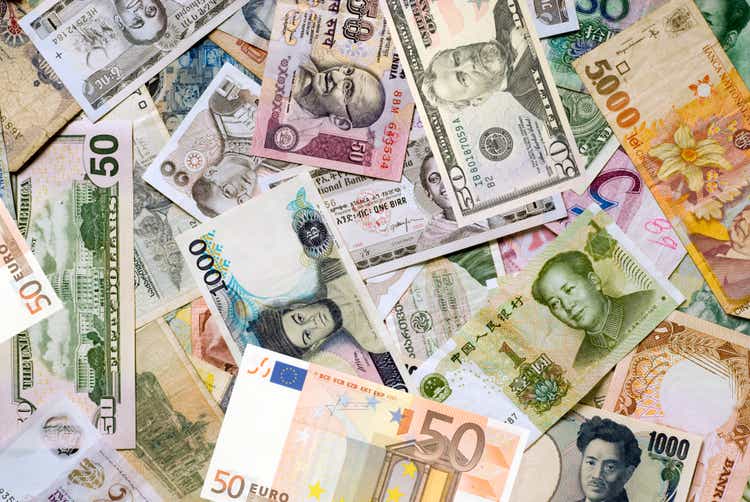FrankvandenBergh
Exchange rate volatility increases when central banks are facing strikingly different economic challenges.
Let’s start with the United States where the challenge is the inflation impulse from the massive pandemic fiscal stimulus supported by the asset purchases of the Federal Reserve. The fiscal stimulus is in the past, and the Fed is now raising rates and shrinking its balance sheet. But demand-driven inflation does not have an on/off switch and may take considerable time to subside, even after the sources of the inflation impulse have been removed or reversed.
Meanwhile, Europe’s inflation problem is more supply-driven than in the U.S., with natural gas and electricity prices soaring due in large part to the Russia-Ukraine war. Moreover, supply shocks make the likelihood of recession much higher in Europe than in the U.S. There is little a central bank can do about supply-side inflation, and with a recession looming, the European Central Bank has lagged the Fed and allowed the policy differential to be reflected in the dollar-to-euro exchange rate.

The U.K. faces many problems similar to those in Europe, with the inflation being supply shock driven and focused on electricity and natural gas. Unfortunately for the U.K., the inflation pressure is even higher and probably more pervasive than in the rest of Europe. The Bank of England has responded by raising rates – more than the ECB but less than the Fed. At the same time, the U.K. is planning some large tax cuts to help consumers. This fiscal-monetary combination has fed through to a depreciation of the British pound relative to the U.S. dollar.

Over in Japan, the country has not yet seen the kind of inflation being observed in the U.S., Europe and the U.K. After decades of deflationary psychology by Japanese consumers, the Bank of Japan is welcoming a bit of inflation and has steadfastly maintained its zero-rate and yield curve control policies. The possible trigger for a shift in BOJ policy might occur depending on the extent of the depreciation of the Japanese yen against the U.S. dollar. Japan is a commodities importer, and commodities are priced in U.S. dollars, so the currency weakness is starting to impact the economy even though the flow-through to consumer prices has been relatively muted so far.

Last but not least is China, which is facing completely different challenges. The COVID-zero policy and various partial shutdowns of cities has greatly depressed consumer demand. At the same time, worsening debt problems in the property sector have also made consumers more reluctant to spend. China is pushing new loans into the economy to stimulate infrastructure construction projects, and the People’s Bank of China has made incremental cuts in interest rates. All these factors have contributed to the depreciation of the yuan against the U.S. dollar.

With central banks from the major currencies facing different economic challenges, it is no wonder that policy responses have diverged – which can make for considerable exchange rate volatility.
Source: CME Group
Japan and the U.K. face conflicting challenges as well, reflected in different central bank policy paths. FX volatility is not likely to subside anytime soon.
| All examples are hypothetical interpretations of situations and are used for explanation purposes only. The views expressed in OpenMarkets articles reflect solely those of their respective authors and not necessarily those of CME Group or its affiliated institutions. OpenMarkets and the information herein should not be considered investment advice or the results of actual market experience. Neither futures trading nor swaps trading are suitable for all investors, and each involves the risk of loss. Swaps trading should only be undertaken by investors who are Eligible Contract Participants (ECPs) within the meaning of Section 1a(18) of the Commodity Exchange Act. Futures and swaps each are leveraged investments and, because only a percentage of a contract’s value is required to trade, it is possible to lose more than the amount of money deposited for either a futures or swaps position. Therefore, traders should only use funds that they can afford to lose without affecting their lifestyles and only a portion of those funds should be devoted to any one trade because traders cannot expect to profit on every trade. BrokerTec Americas LLC (“BAL”) is a registered broker-dealer with the U.S. Securities and Exchange Commission, is a member of the Financial Industry Regulatory Authority, Inc. (www.FINRA.org), and is a member of the Securities Investor Protection Corporation (www.SIPC.org). BAL does not provide services to private or retail customers. In the United Kingdom, BrokerTec Europe Limited is authorised and regulated by the Financial Conduct Authority. CME Amsterdam B.V. is regulated in the Netherlands by the Dutch Authority for the Financial Markets (AFM) (www.AFM.nl). CME Investment Firm B.V. is also incorporated in the Netherlands and regulated by the Dutch Authority for the Financial Markets (AFM), as well as the Central Bank of the Netherlands (DNB). |
Editor’s Note: The summary bullets for this article were chosen by Seeking Alpha editors.


Be the first to comment